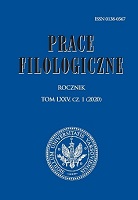Po ziemi, po zimie, po trawce, na słomce? – o poziomce w polskiej kulturze ludowej
On the Ground, After Winter, on the Grass, on a Straw? – about Wild Strawberry in Polish Folk Culture
Author(s): Katarzyna ProrokSubject(s): Customs / Folklore, Lexis, Sociolinguistics, Cultural Anthropology / Ethnology
Published by: Wydział Polonistyki Uniwersytetu Warszawskiego
Keywords: ethnolinguistic dictionary; linguocultural worldview; stereotype; symbol; berries;
Summary/Abstract: The author presents the preliminary version of the Dictionary of folk stereo-types and symbols entry pertaining to the wild strawberry. The linguacultural view of wild strawberry can be reconstructed primarily on the basis of synonyms, e.g. poziomka (because it grows low, po ziemi [‘on the ground’]), pozimka (it appears in early spring, po zimie [‘right after winter’]), potrawnica (it grows po trawie [‘on the grass’] or po(na) trawce[‘on a thin stem’]), dzika truskawka [wild strawberry], leśna malina [forest raspberry] (it grows wild, usually in the forest and it resembles a strawberry or a raspberry) etc. Folk legends and beliefs associate wild strawberries with the Mother of God – she created them to protect people from cruel hunger during the hungry gap. She is also believed to feed dead children in heaven with wild strawberries. Ethnographic records of folk practices provide information that sweet, fragrant wild strawberries were an important supplement to the daily diet of the villagers, often lacking in nutrients. Along with the leaves and stems, the plants were also used in medicine, e.g. to heal skin and respiratory problems.
Journal: Prace Filologiczne
- Issue Year: 75/2020
- Issue No: 2
- Page Range: 195-209
- Page Count: 15
- Language: Polish

